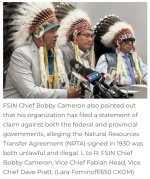Why is a sperm whales throat this big

?
Anyway, SASKATOON — Canada’s premiers are meeting with Prime Minister Mark Carney in person for the first time since the federal election to pitch which major projects they think should get fast-tracked.
The recent campaign saw Carney vow to slash federal approval times on major infrastructure projects considered to be in the national interest to help make the country an “energy superpower.”
Premier Scott Moe said he’s been clear in the interest Saskatchewan has in doing its part to make sure Canada achieves Carney’s goals — however, he reiterated that being an energy superpower means all forms of energy, including oil and gas.
The full list of big industrial projects they’re discussing is being kept secret, since they don’t want to send a bad signal about anything that doesn’t make the short list.
Eleven Saskatchewan First Nations chiefs say they're upset and concerned that they've collectively been left out of the discussions during the First Ministers' meetings in Saskatoon.

www.cjme.com
Keep in mind this is the “Provincial Premiers” (=First Ministers) first meeting with the new PM…and not the First Ministers (=Provincial Premiers) & 11 Saskatchewan First Nations Chiefs meeting with the PM.

Eleven Saskatchewan First Nations chiefs say they’re upset and concerned that they’ve collectively been left out of the discussions during the First Ministers’ meetings in Saskatoon….even though they’re not first ministers (Provincial Premiers).
According to the Federation of Sovereign Indigenous Nations (FSIN) Vice Chief Dutch (Edward) Lerat, the exclusion represents a fundamental breach of the federal government’s constitutional obligations.
“The agenda items for the First Ministers’ meeting here in Saskatoon are internal trade, tariffs, pipelines, and major projects. These are all critical matters that directly impact our inherent treaty rights and constitutional rights, including rights to our lands, waters, medicines, and all living things,” he said, etc…
He said no one can deny the resources and critical minerals that are or will be extracted are from treaty and traditional lands.
“So, let’s be clear: any conversation about internal trade, tariffs, pipelines, or major projects must include our First Nations,” he added.
FSIN Vice Chief Craig McCallum said collectively that they’re not against development.
“We are for the protection of our lands, our sovereignty, and our right to determine our future, and that is up to our nations,” he said.
Other chiefs added that the wealth generated from resource development would should benefit everyone, including First Nations., and that while Prime Minister Mark Carney and the country’s premiers have been consistently speaking out against the way U.S. President Donald Trump has treated Canada, they feel as though Canada has treated them in the same manner, etc…
FSIN Chief Bobby Cameron also pointed out that his organization has filed a statement of claim against both the federal and provincial governments, alleging the Natural Resources Transfer Agreement (NRTA) signed in 1930 was both unlawful and illegal.



